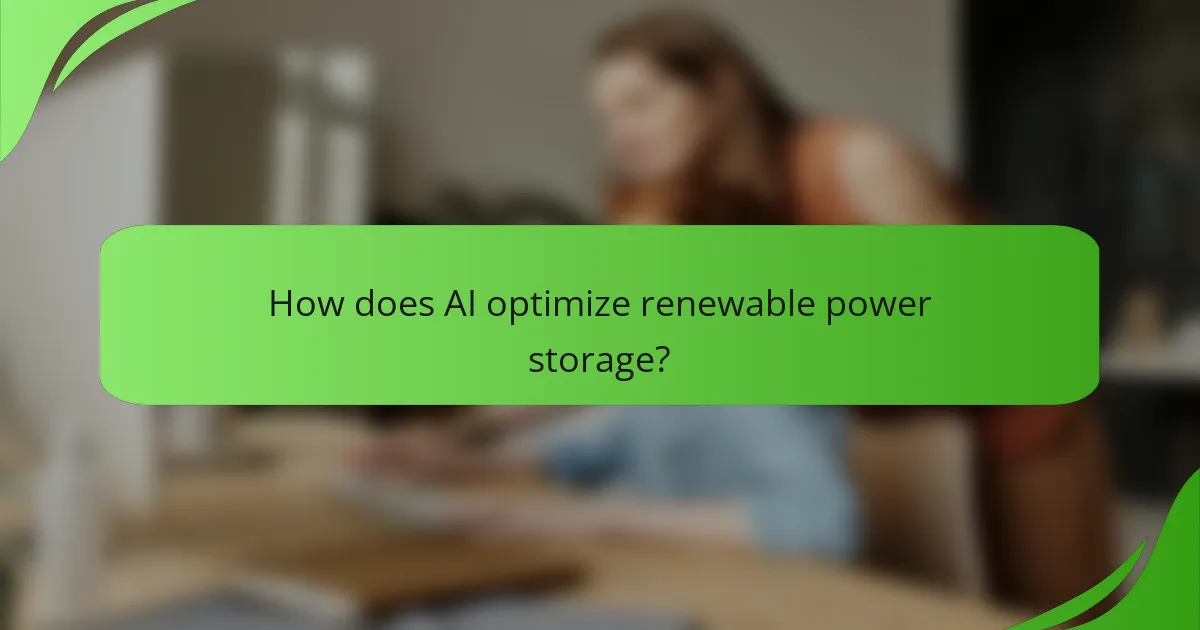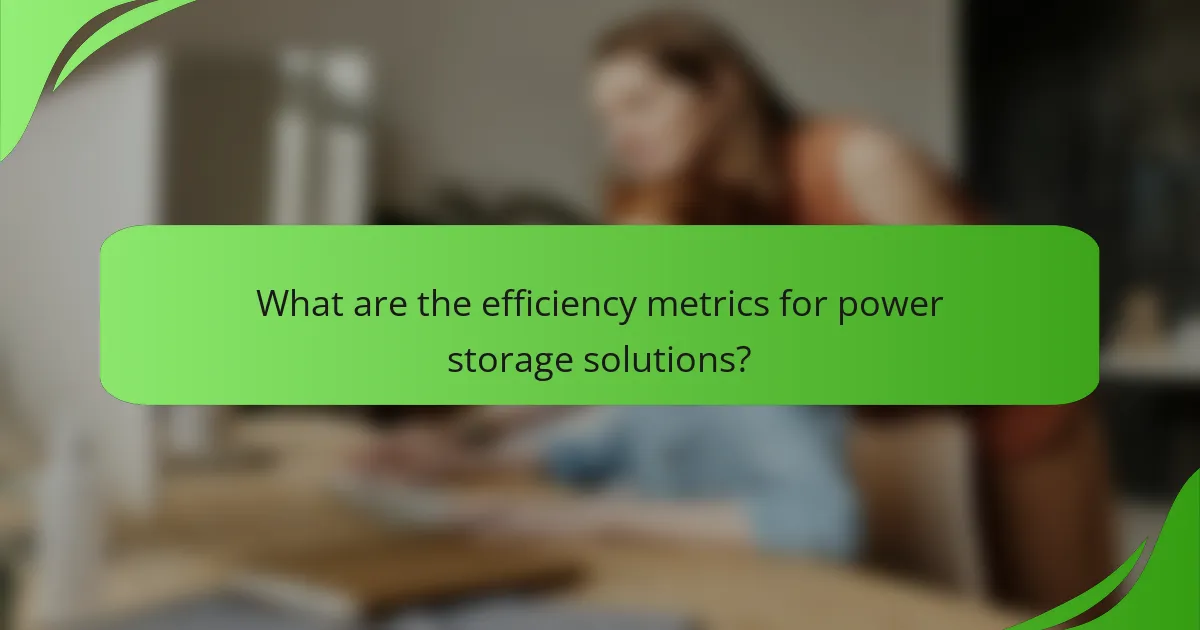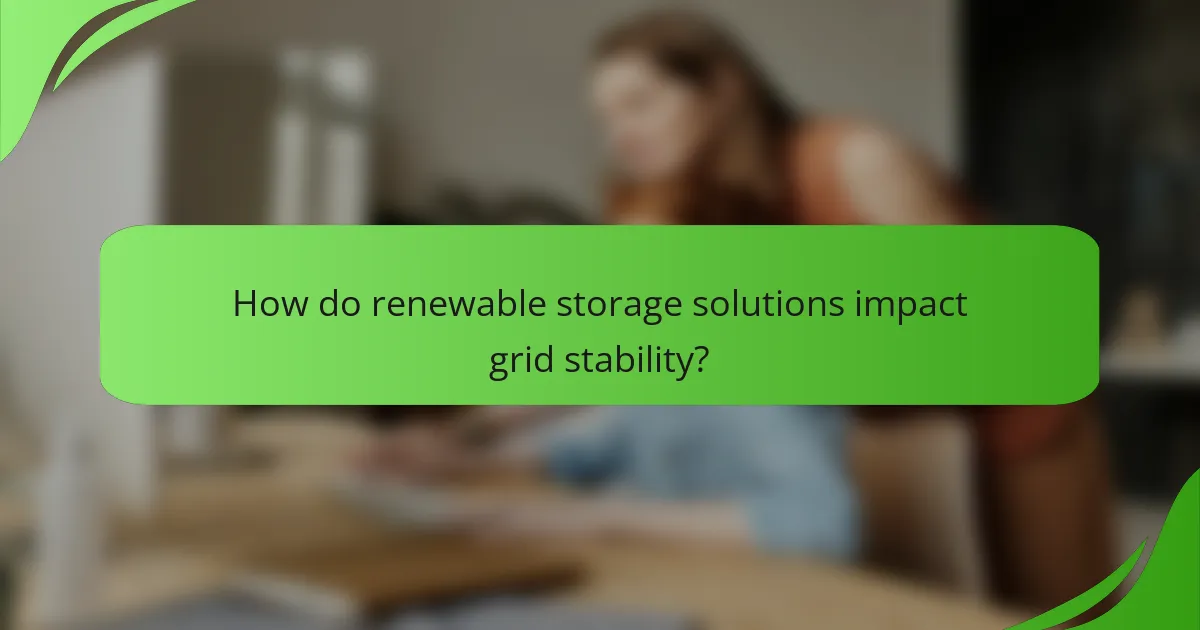As the demand for renewable energy grows, effective power storage solutions become essential for maximizing efficiency and reliability. Technologies such as lithium-ion batteries, pumped hydro storage, and flow batteries each present unique benefits tailored to various applications. By leveraging AI for predictive analytics and real-time monitoring, these storage systems can optimize energy management, ensuring that renewable resources are utilized effectively while minimizing waste.

What are the best renewable power storage solutions in the USA?
The best renewable power storage solutions in the USA include lithium-ion batteries, pumped hydro storage, flow batteries, compressed air energy storage, and solid-state batteries. Each solution offers unique advantages and trade-offs, making them suitable for different applications in the renewable energy landscape.
Lithium-ion batteries
Lithium-ion batteries are widely used for energy storage due to their high energy density and efficiency. They are commonly found in electric vehicles and residential solar systems, providing quick discharge and recharge capabilities.
Consider their lifespan, which typically ranges from 5 to 15 years, and their ability to operate in various temperatures. However, they can be costly, with prices often exceeding $300 per kWh, so evaluating the total cost of ownership is crucial.
Pumped hydro storage
Pumped hydro storage is the most established form of large-scale energy storage, utilizing two water reservoirs at different elevations. During low demand, excess energy is used to pump water uphill, which can later be released to generate electricity when demand peaks.
This method is highly efficient, with round-trip efficiencies around 70-90%. However, it requires significant geographical considerations and can have environmental impacts, making site selection critical.
Flow batteries
Flow batteries store energy in liquid electrolytes, allowing for scalable energy storage solutions. They are particularly suited for long-duration applications, providing discharge times from several hours to days.
While flow batteries have lower energy density compared to lithium-ion batteries, their longer lifespan and ability to be easily recharged make them a viable option for grid-scale storage. Costs are gradually decreasing, but they still can be higher than traditional batteries.
Compressed air energy storage
Compressed air energy storage (CAES) involves storing energy by compressing air in underground caverns or tanks. When energy is needed, the compressed air is heated and expanded to drive turbines, generating electricity.
This method can provide large-scale storage with efficiencies around 60-70%. However, it requires specific geological formations and can have higher upfront costs, making it less common than other storage solutions.
Solid-state batteries
Solid-state batteries use solid electrolytes instead of liquid ones, offering higher energy densities and improved safety. They are still in the development phase but show promise for future applications in electric vehicles and grid storage.
These batteries can potentially reduce the risk of fires and extend lifespan, but they are currently more expensive to produce than lithium-ion batteries. As technology advances, costs are expected to decrease, making them a competitive option in the renewable energy storage market.

How does AI optimize renewable power storage?
AI optimizes renewable power storage by analyzing data patterns to enhance efficiency and reliability. Through predictive analytics, real-time monitoring, and advanced algorithms, AI helps manage energy resources effectively, ensuring that stored energy meets demand while minimizing waste.
Predictive analytics for energy demand
Predictive analytics uses historical data and machine learning to forecast energy demand. By analyzing trends, AI can anticipate peak usage times, allowing storage systems to prepare accordingly. This ensures that energy is available when needed most, reducing reliance on fossil fuels during high-demand periods.
For instance, utilities can leverage predictive models to adjust energy storage levels in anticipation of seasonal changes or special events, optimizing resource allocation and minimizing costs.
Real-time monitoring and management
Real-time monitoring involves continuously tracking energy storage systems to assess performance and detect anomalies. AI algorithms analyze this data to make immediate adjustments, enhancing system responsiveness and efficiency. This capability is crucial for integrating renewable sources like solar and wind, which can be variable.
By employing IoT devices, energy providers can gather real-time data on storage levels and energy flow, enabling proactive management. This reduces the risk of overcharging or discharging batteries, prolonging their lifespan and maintaining optimal performance.
Enhanced battery life through AI algorithms
AI algorithms can significantly extend battery life by optimizing charge and discharge cycles. By analyzing usage patterns, these algorithms adjust charging rates and times, preventing overcharging and deep discharging, which can degrade battery health.
For example, AI can determine the best times to charge batteries based on energy prices and demand forecasts, ensuring that batteries are used efficiently. This not only enhances battery longevity but also reduces operational costs associated with energy storage systems.

What are the efficiency metrics for power storage solutions?
Efficiency metrics for power storage solutions are critical for evaluating their performance and viability. Key metrics include round-trip efficiency, energy density, and cost per cycle, which collectively inform users about how effectively energy is stored and utilized.
Round-trip efficiency
Round-trip efficiency measures the energy retained after storage and retrieval processes. It is expressed as a percentage, indicating how much of the input energy can be used again. For many battery technologies, this efficiency typically ranges from 70% to 90%.
Higher round-trip efficiency means less energy loss, making the system more economical over time. When selecting a storage solution, consider the round-trip efficiency as a key factor in determining overall effectiveness.
Energy density
Energy density refers to the amount of energy stored per unit volume or weight, usually measured in watt-hours per liter (Wh/L) or watt-hours per kilogram (Wh/kg). Higher energy density allows for more energy storage in a smaller space, which is particularly important for mobile applications like electric vehicles.
For instance, lithium-ion batteries typically offer energy densities around 150-250 Wh/kg, while newer technologies like solid-state batteries promise even higher densities. When assessing energy storage options, prioritize energy density based on your specific space and weight constraints.
Cost per cycle
Cost per cycle calculates the expense associated with each charge and discharge cycle of a storage solution. This metric is crucial for understanding the long-term financial implications of using a particular technology. Costs can vary widely, with some solutions costing as low as $0.05 to $0.20 per cycle.
When evaluating storage options, consider both the initial investment and the cost per cycle to determine the most cost-effective solution over its lifespan. Be cautious of solutions that may have low upfront costs but high operational expenses, as they can lead to increased total costs over time.

What factors should be considered when choosing a storage solution?
When selecting a renewable power storage solution, key factors include initial investment costs, maintenance requirements, and scalability options. These elements significantly influence the overall efficiency and long-term viability of the storage system.
Initial investment costs
Initial investment costs encompass the purchase price of the storage technology, installation expenses, and any necessary infrastructure upgrades. For example, lithium-ion batteries may range from several hundred to a few thousand USD per kilowatt-hour, depending on capacity and technology.
Consider the total cost of ownership, which includes not just the upfront costs but also potential savings on energy bills and incentives available in your region. Research local subsidies or tax credits that can offset these initial expenses.
Maintenance requirements
Maintenance requirements vary widely among storage solutions. Some technologies, like pumped hydro storage, require minimal upkeep, while others, such as battery systems, may need regular monitoring and periodic replacements.
Evaluate the expected lifespan of the storage system and factor in maintenance costs when calculating total expenses. A system with lower maintenance needs may offer better long-term value, even if it has a higher initial investment.
Scalability options
Scalability options refer to the ability to expand the storage capacity as energy needs grow. Some systems allow for easy addition of units, while others may require significant redesign or investment to scale up.
Choose a solution that can adapt to future energy demands without excessive costs or complications. For instance, modular battery systems can be expanded incrementally, making them a flexible choice for many applications.

How do renewable storage solutions impact grid stability?
Renewable storage solutions enhance grid stability by balancing supply and demand, particularly during fluctuations in energy generation. They provide a buffer that can absorb excess energy and release it when production dips, ensuring a consistent power supply.
Benefits of Renewable Storage Solutions
Renewable storage solutions offer several advantages, including improved reliability and reduced dependency on fossil fuels. By storing energy generated from sources like solar and wind, these systems help maintain a steady energy flow, particularly during peak demand periods.
Additionally, they can lower energy costs by allowing utilities to shift energy usage to off-peak times, optimizing overall grid efficiency. This can lead to significant savings for consumers and businesses alike.
Types of Renewable Storage Technologies
Common renewable storage technologies include lithium-ion batteries, pumped hydro storage, and compressed air energy storage. Lithium-ion batteries are widely used for their efficiency and scalability, making them suitable for both residential and commercial applications.
Pumped hydro storage, while more site-specific, can store large amounts of energy and is often employed for grid-scale solutions. Compressed air energy storage is another alternative, utilizing underground caverns to store energy in the form of compressed air.
Challenges and Considerations
While renewable storage solutions are beneficial, they come with challenges such as high initial costs and limited lifespan for certain technologies. It’s crucial to evaluate the total cost of ownership, including installation, maintenance, and replacement costs over time.
Moreover, regulatory frameworks can impact the deployment of these technologies. Understanding local regulations and incentives can help stakeholders make informed decisions about integrating storage solutions into the grid.
